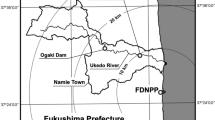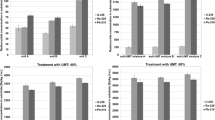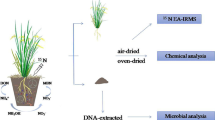Abstract
It has been recognized that carbon-14 (14C) is one of the dominant radionuclides affecting dose from transuranic (TRU) wastes. This radionuclide has a decay half-life of 5,730 years, and 14C organic materials have very low sorption properties to clay and rock in the environment, which raises some concerns about the releases of 14C to the biosphere from radioactive waste repositories. For the safety assessment of TRU waste disposal, we studied the behavior of 14C in rice paddy field soils. We also determined key parameters such as soil–soil solution distribution coefficients (K ds) and soil-to-rice plant transfer factors (TFs) of 14C in the field soils. The TFs were obtained in laboratory and field experiments. In our laboratory experiments, we used [1,2-14C] sodium acetate as a source of 14C because it has been suggested that low molecular weight organic-14C compounds are released from metallic TRU wastes. The results showed that 14C-bearing sodium acetate in irrigated paddy soils was rapidly decomposed by indigenous bacteria. Although some of the 14C was assimilated into the bacterial cells, most of the 14C was released into the air as gaseous compounds. The main chemical species of 14C gases was 14CO2, and a part of the released 14CO2 gas was used by rice plants during photosynthesis. Only a negligible amount of 14C was absorbed through the roots. Therefore, the contamination of rice plants is mainly caused by gasification of 14C, and microorganisms are responsible for driving this process. The activity of microorganisms is a key issue in the behavior of 14C in paddy fields.
You have full access to this open access chapter, Download chapter PDF
Similar content being viewed by others
Keywords
1 Introduction
Transuranic (TRU) wastes contain a variety of radionuclides, for example, Np, Pu, and long-lived radionuclides such as 14C and 129I. In Japan these wastes are categorized into four groups in accordance with their physical properties and the concentration of radioactive materials. Group two waste includes hull and end piece wastes with relatively high amounts of 14C, and leaching of low molecular weight 14C organic materials from simulated hull wastes has been reported [1]. The 14C organic materials have very few sorption properties to clay and rock, and 14C has a relatively long half-life of 5,730 years. These properties raise concerns about releases of 14C to the biosphere from radioactive waste repositories.
Rice is a major agricultural crop throughout Asia, and thus human exposure to 14C through rice intake must be considered. To reduce the risk of the internal radiation dose from 14C, it is important to clarify the behavior of 14C in rice paddy fields. In this study, we determined transfer pathways of 14C through the rice paddy fields to rice grains. Environmental parameters such as soil–soil solution distribution coefficients (K ds) and soil-to-rice plant transfer factors (TFs) of 14C were also determined, because these parameters are often used in transfer models to predict the behavior of radionuclides in the environment. From a series of our experimental results, we describe the behavior of 14C in rice paddy field soils and the importance of microbial activity.
2 Partitioning of 14C into Solid, Liquid, and Gas Phases
We carried out batch sorption experiments using 63 Japanese rice paddy soil samples to clarify the transfer pathways of 14C in rice paddy fields. The soil samples were collected throughout Japan and taken to our laboratory where they were air dried and sieved (<2 mm). These sieved soils were mixed with a [1,2-14C] sodium acetate solution at the ratio of soil : solution = 0.5 g : 5 ml, and the flooded soil samples were incubated at 25 °C for 7 days [2]. During the incubation period, the 14C atoms of the sodium acetate were partitioned into solid, liquid, and gas phases. Each partitioning ratio is shown in Fig. 26.1. Approximately 63 % of the total 14C on average was released into the air as gaseous compounds. Partitioning ratios into solid and liquid phases were 34 % and 3 %, respectively. These results suggest that gasification is an important pathway in the environmental transfer of 14C in Japanese rice paddy fields.
When 14C is released into the air, 14C-bearing gases must pass through the soil solution. Because soil solution pH affects chemical reactions such as hydrolysis and degassing of CO2, chemical forms of 14C-bearing gases may change in the soil solution. We, therefore, investigated relationships between pH and partitioning ratios of 14C into the liquid phase at day 7 of incubation (Fig. 26.2). The partitioning ratio increased with increasing in pH, and a significant correlation (r = 0.7) was found. These data fit well with the solubility curve of total carbonic acid in water, which refers to the sum of dissolved carbon dioxide and the carbonic acid. This observation suggested that the dominant chemical species of 14C in gas forms was carbon dioxide. To confirm the effect of pH on the partitioning of 14C into the liquid phase, a soil sample was suspended in MES [2-(N-morpholino)ethanesulfonic acid] buffers with the initial pH value adjusted to 5.5, 6.5, and 7.5 (Fig. 26.3). A control sample was prepared consisting of the soil and deionized water (pH unadjusted). The partitioning ratio also increased with increasing pH, suggesting that the partitioning ratio of 14C into the liquid phase depended on the pH of the soil solution.
Soil–soil solution distribution coefficient (K d) is a commonly used parameter to evaluate behaviors of radionuclides in the environment. In our study, the K d values were calculated from activities of the 14C in the solid and liquid phases at the end of incubation, and the obtained K d value was 139 ± 77 ml g−1 on average. Negatively charged anions generally have low K d values because of simple electrostatic interaction. Our value, however, was higher than expected from the chemical form of 14CH3 14COO−. For example, Kaneko et al. [1] obtained the K d value of 9.5 ml g−1 for the sorption test of acetic acid using cement materials. The reason for our high K d value is explained next.
3 Involvement of Microorganisms in the 14C Behavior
Many microorganisms inhabit rice paddy fields, and they are responsible for nutrient cycling. We studied the involvement of microorganisms in environmental transfer of 14C. Microorganisms in batch cultures were treated with autoclaving (121 °C, 15 min), mixing with glutaraldehyde [final concentration of 2.5 % (vol/vol)], and mixing with cycloheximide (final concentration, 250 μg ml−1). Autoclaving and expose to glutaraldehyde inactivate bacteria and fungi, but exposure to cycloheximide only inhibits fungi. The partitioning ratios of 14C into solid, liquid, and gas phases for each treatment sample are listed in Table 26.1. When microorganisms were treated by autoclaving and exposing to glutaraldehyde, almost all the 14C added remained in the liquid phase; that is, negligible transformation of 14C occurred. On the other hand, the 14C atoms in the control and the cycloheximide-treated sample were partitioned into solid, liquid, and gas phases at certain ratios, and these ratios were similar between the control and the cycloheximide samples. We confirmed fungi made no contribution to partitioning of 14C based on these results. We concluded that environmental transfer of 14C in rice paddy fields was driven by bacteria, not by fungi.
To confirm incorporation of 14C into bacteria cells, bacteria that were isolated from a flooding water of a paddy soil sample were cultivated on agar plates containing [1,2-14C] sodium acetate [3]. After cultivation, bacterial colonies were formed, and their autoradiography images showed that all colonies had the ability to take up 14C (Fig. 26.4). In our experimental procedure, bacterial cells were consequently partitioned into the solid phase, and thus the solid phase contains the 14C incorporated by bacteria, which could be one of the reasons for the relatively high K d values.
4 Transfer of 14C from Soil to Rice Plants
Soil-to-rice plant transfer factors (TFs) of 14C, which was defined as 14C concentration in rice grains (Bq/kg-dry) divided by that in soil (Bq/kg-dry), were determined by laboratory and field experiments. In the laboratory experiment using a growth chamber, we grew rice plants with addition of [1,2-14C] sodium acetate. This 14C compound was supplied once to rice plants in the flooding water just before blooming, and TF of 6.8 ± 2.4 on average was obtained. In these tracer experiments, rice plants were also cultivated without [1,2-14C] sodium acetate as negative controls in the same growth chamber as the 14C-treated rice. Interestingly 14C was detected even from the rice grains of negative control samples. These results suggested that the 14C-bearing gas, which was released from bacterial cells in rice paddy soils, was fixed by the rice plants in the negative controls through photosynthesis.
We also examined the possibility of root uptake of 14C by stable isotope techniques under field conditions [4]. If plant carbon originates from the atmospheric CO2, the δ13C values in crops can be calculated using the δ13C value, −8 ‰ in air [5], and the 13C fractionation ratio in photosynthesis by rice plants of −18 to −20 ‰ [6, 7]. The calculated δ13C values in our study ranged from −28 ‰ to −26 ‰, and the results implied that no soil carbon contribution occurred for white rice; however, by setting some conditions, for example, 13C fractionation ratio of 19‰, we obtained the average TF value of 0.11 ± 0.04 for white rice. To compare these TF values obtained in laboratory and field experiments, it is necessary to pay attention to the difference between [1,2-14C] sodium acetate and the actual organic compounds present in the natural soil.
5 Behavior of 14C in Rice Paddy Fields
From the aforementioned results, the behavior of 14C in rice paddy fields could be considered as follows (a conceptual diagram appears in Fig. 26.5). When irrigation water is contaminated by 14C-bearing sodium acetate, the 14C compound is taken up and metabolized by indigenous bacteria. A part of the 14C is assimilated by the bacterial cells, and the rest of the 14C is released as gaseous compounds from the cells as a result of dissimilation. The dominant chemical species of 14C in gas forms is carbon dioxide, and thus some of the released 14CO2 is dissolved in soil solution depending on pH. For example, when the pH of the soil solution is less than 6.5, most of 14C in gas forms is released into the air. The released 14CO2 is eventually taken up by rice plants during photosynthesis. When the pH of the soil solution is between 6.5 and 10.5, 14C-bearing bicarbonate ion dominates in the soil solution. In addition, once 14CO2 has been released into the air, a part of the 14CO2 gas may be redissolved in the soil solution again as bicarbonate ion. When the pH of the soil solution is greater than 10.5, although this is not probable in paddy fields, 14C-bearing carbonate ion dominates in the soil solution. Carbonate ion is thermally unstable and thus precipitates as carbonate minerals such as CaCO3. In these alkaline situations, the ratio of 14C in the solid phase may increase as a result of the precipitation of 14C. Because the root uptake of 14C by rice plants is negligible, gasification of 14C is an important environmental transfer pathway for the safety assessment of TRU wastes, and bacteria are responsible for driving this pathway.
References
Kaneko S, Tanabe H, Sasoh M, Takahashi R, Shibano T, Tateyama S (2002) A study on the chemical forms and migration behavior of carbon-14 leached from the simulated hull waste in the underground condition. MRS Proc 757:621–626
Ishii N, Koiso H, Takeda H, Uchida S (2010) Partitioning of C-14 into solid, liquid, and gas phases in various paddy soils in Japan. J Nucl Sci Technol 47:238–243
Ishii N, Uchida S (2011) Bacteria contributing to behavior of radiocarbon in sodium acetate. Radiat Prot Dosimetry 146:151–154
Tagami K, Uchida S (2010) Estimation of carbon-14 transfer from agricultural soils to crops using stable carbon isotope ratios. Waste Manag Symp Proc 36(10346):1–6
Ciais P, Tans P, Trolier M, White J, Francey R (1995) A large northern hemisphere terrestrial CO2 sink indicated by the 13C/12C ratio of atmospheric CO2. Science 269:1098–1102
O’Leary M (1981) Carbon isotope fractionation in plants. Phytochemistry 20:553–567
Lloyd J, Farquhar GD (1994) 13C discrimination during CO2 assimilation by the terrestrial biosphere. Oecologia (Berl) 99:201–215
Acknowledgments
This work has been partially supported by the Agency for Natural Resources and Energy, the Ministry of Economy, Trade and Industry (METI), Japan.
Author information
Authors and Affiliations
Corresponding author
Editor information
Editors and Affiliations
Rights and permissions
Open Access This chapter is distributed under the terms of the Creative Commons Attribution Noncommercial License, which permits any noncommercial use, distribution, and reproduction in any medium, provided the original author(s) and source are credited.
Copyright information
© 2015 The Author(s)
About this chapter
Cite this chapter
Ishii, N., Ogiyama, S., Sakurai, S., Tagami, K., Uchida, S. (2015). Environmental Transfer of Carbon-14 in Japanese Paddy Fields. In: Nakajima, K. (eds) Nuclear Back-end and Transmutation Technology for Waste Disposal. Springer, Tokyo. https://doi.org/10.1007/978-4-431-55111-9_26
Download citation
DOI: https://doi.org/10.1007/978-4-431-55111-9_26
Published:
Publisher Name: Springer, Tokyo
Print ISBN: 978-4-431-55110-2
Online ISBN: 978-4-431-55111-9
eBook Packages: Earth and Environmental ScienceEarth and Environmental Science (R0)









